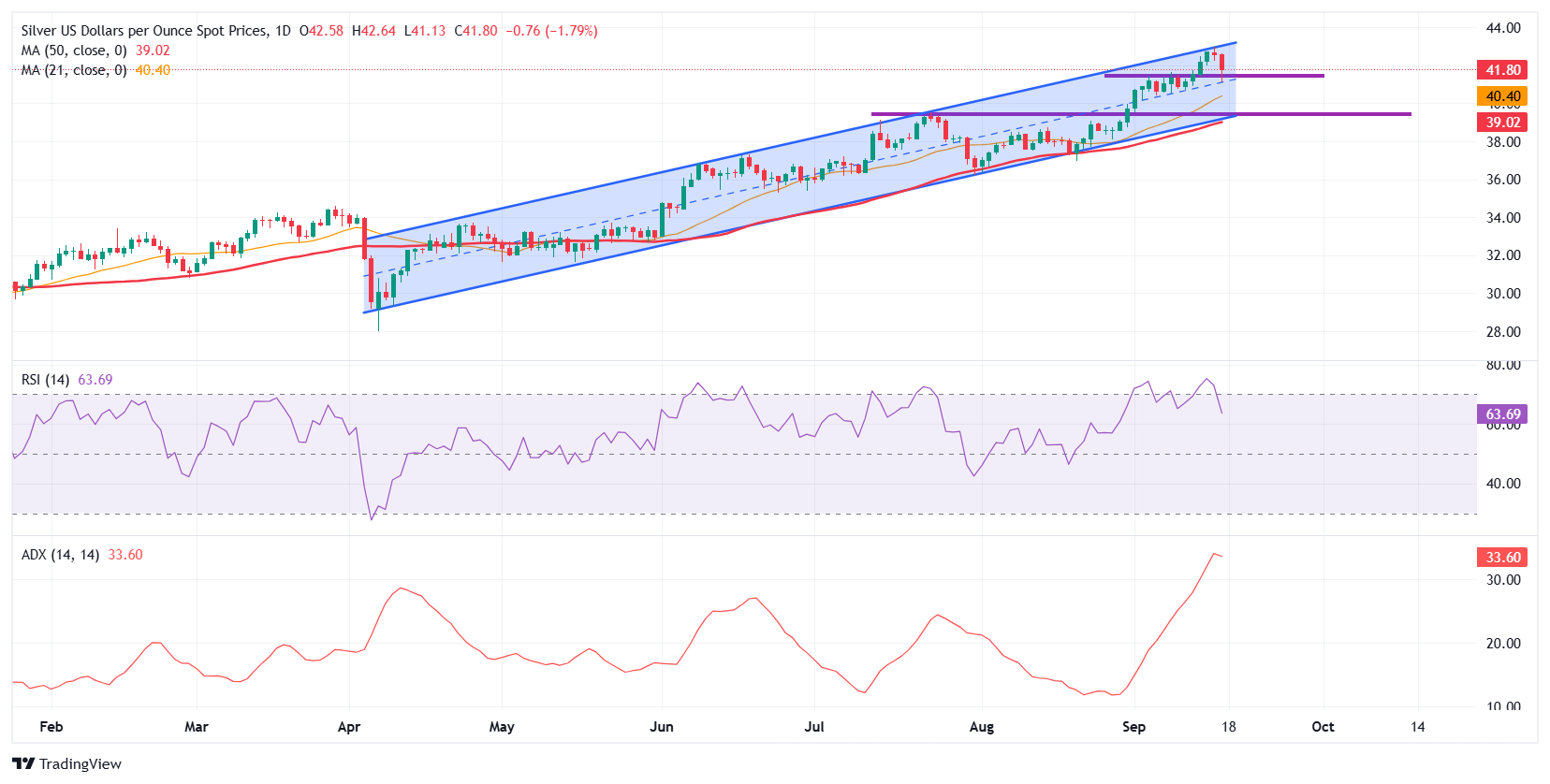Silver Price Forecast: XAG/USD steadies ahead of Fed interest rate decision
- Silver trims earlier losses after dipping to a five-day low, with traders cautious ahead of the Fed’s interest rate decision.
- The Fed is expected to cut rates by 25 bps, with Powell’s guidance likely to shape the near-term path for markets.
- Momentum indicators show consolidation, with RSI at 64 and ADX at 34 keeping the broader uptrend intact.
Silver (XAG/USD) trims some of its earlier losses on Wednesday after dipping to a five-day low, with traders reluctant to take fresh positions ahead of the Federal Reserve’s (Fed) interest rate decision at 18:00 GMT.
The white metal hit a fresh 14-year high of $42.97 on Tuesday before retreating, pressured by profit-taking and a steadier US Dollar (USD). At the time of writing, XAG/USD trades around $41.90, down nearly 1.70% on the day, with markets squarely focused on the Fed’s first expected rate cut of 2025.
The Fed is widely anticipated to lower the federal funds rate by 25 basis points to the 4.00%-4.25% range. While this move is fully priced in, the spotlight will fall on the updated dot plot and Fed Chair Jerome Powell’s press conference for clues on the pace and depth of the easing cycle. A dovish tone could reignite safe-haven demand and drive Silver back toward recent highs, while a more measured message risks extending the pullback below $41.50.

From a technical perspective, Silver is trading near the midpoint of its rising channel, which coincides with immediate support at $41.50. A sustained hold above this zone would help preserve bullish momentum, with upside targets at $42.50 and the $42.97 peak. Beyond that, a decisive breakout could pave the way for a move toward the psychological $44.00 handle.
On the downside, stronger support is layered around $39.50, where a confluence of factors, including the rising channel’s lower boundary, a horizontal resistance-turned-support level, and the 50-day Simple Moving Average (SMA), form a critical base. A breakdown through this cluster would mark a shift in market structure and expose deeper losses.
Momentum indicators reflect consolidation after a strong run. The Relative Strength Index (RSI) has eased to around 64, cooling from overbought territory but still supportive of an uptrend. Meanwhile, the Average Directional Index (ADX) at 34 confirms that trend strength remains firm. This combination suggests that Silver is in a holding pattern, awaiting the Fed’s policy signal as the catalyst for the next directional move.
Silver FAQs
Silver is a precious metal highly traded among investors. It has been historically used as a store of value and a medium of exchange. Although less popular than Gold, traders may turn to Silver to diversify their investment portfolio, for its intrinsic value or as a potential hedge during high-inflation periods. Investors can buy physical Silver, in coins or in bars, or trade it through vehicles such as Exchange Traded Funds, which track its price on international markets.
Silver prices can move due to a wide range of factors. Geopolitical instability or fears of a deep recession can make Silver price escalate due to its safe-haven status, although to a lesser extent than Gold's. As a yieldless asset, Silver tends to rise with lower interest rates. Its moves also depend on how the US Dollar (USD) behaves as the asset is priced in dollars (XAG/USD). A strong Dollar tends to keep the price of Silver at bay, whereas a weaker Dollar is likely to propel prices up. Other factors such as investment demand, mining supply – Silver is much more abundant than Gold – and recycling rates can also affect prices.
Silver is widely used in industry, particularly in sectors such as electronics or solar energy, as it has one of the highest electric conductivity of all metals – more than Copper and Gold. A surge in demand can increase prices, while a decline tends to lower them. Dynamics in the US, Chinese and Indian economies can also contribute to price swings: for the US and particularly China, their big industrial sectors use Silver in various processes; in India, consumers’ demand for the precious metal for jewellery also plays a key role in setting prices.
Silver prices tend to follow Gold's moves. When Gold prices rise, Silver typically follows suit, as their status as safe-haven assets is similar. The Gold/Silver ratio, which shows the number of ounces of Silver needed to equal the value of one ounce of Gold, may help to determine the relative valuation between both metals. Some investors may consider a high ratio as an indicator that Silver is undervalued, or Gold is overvalued. On the contrary, a low ratio might suggest that Gold is undervalued relative to Silver.

